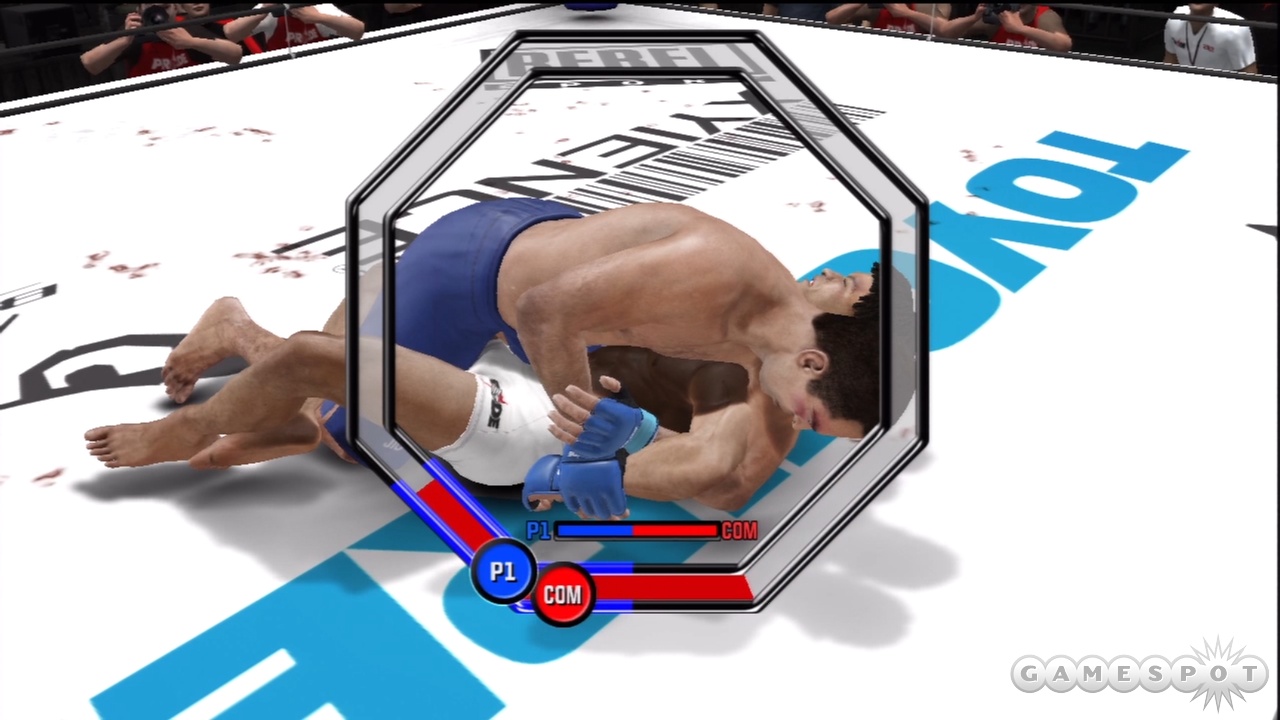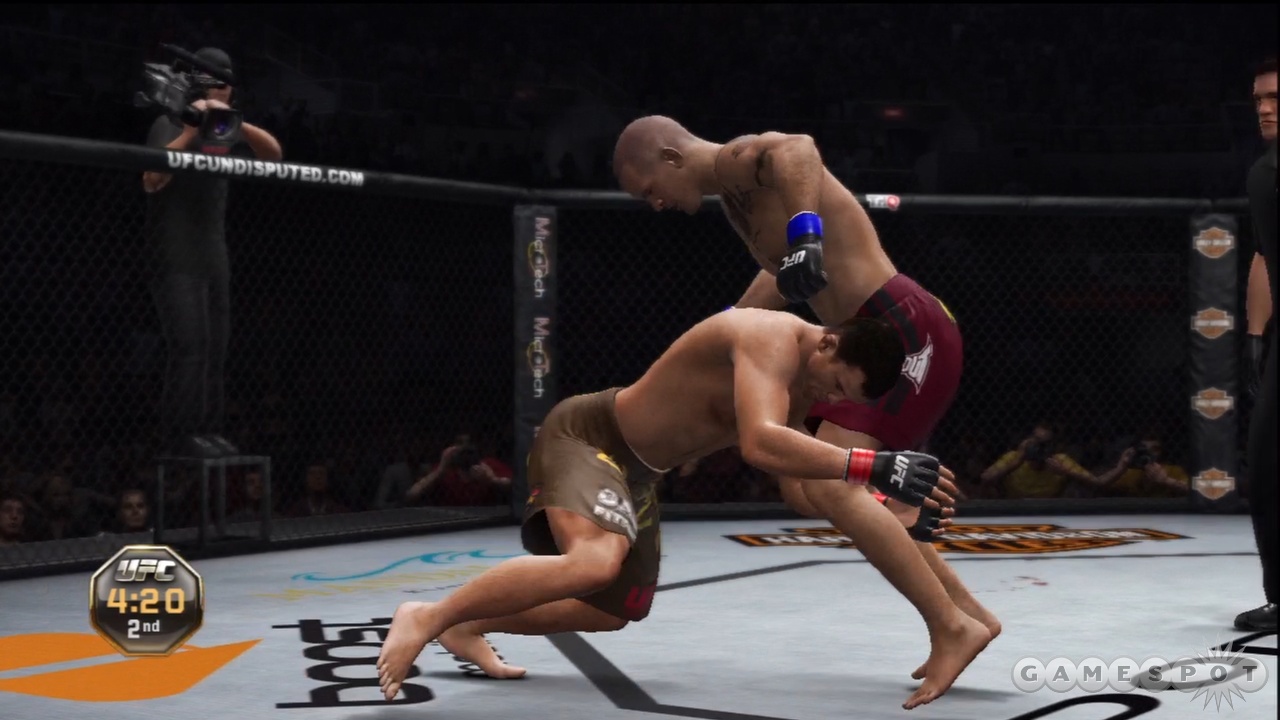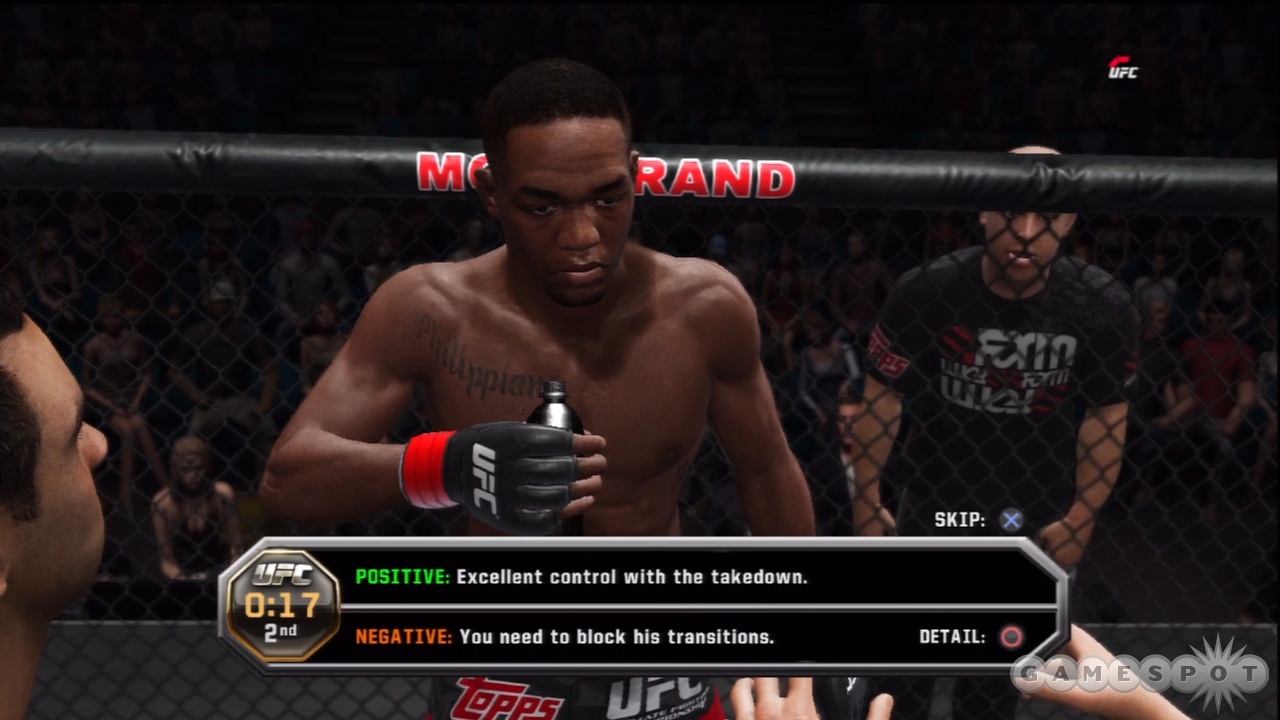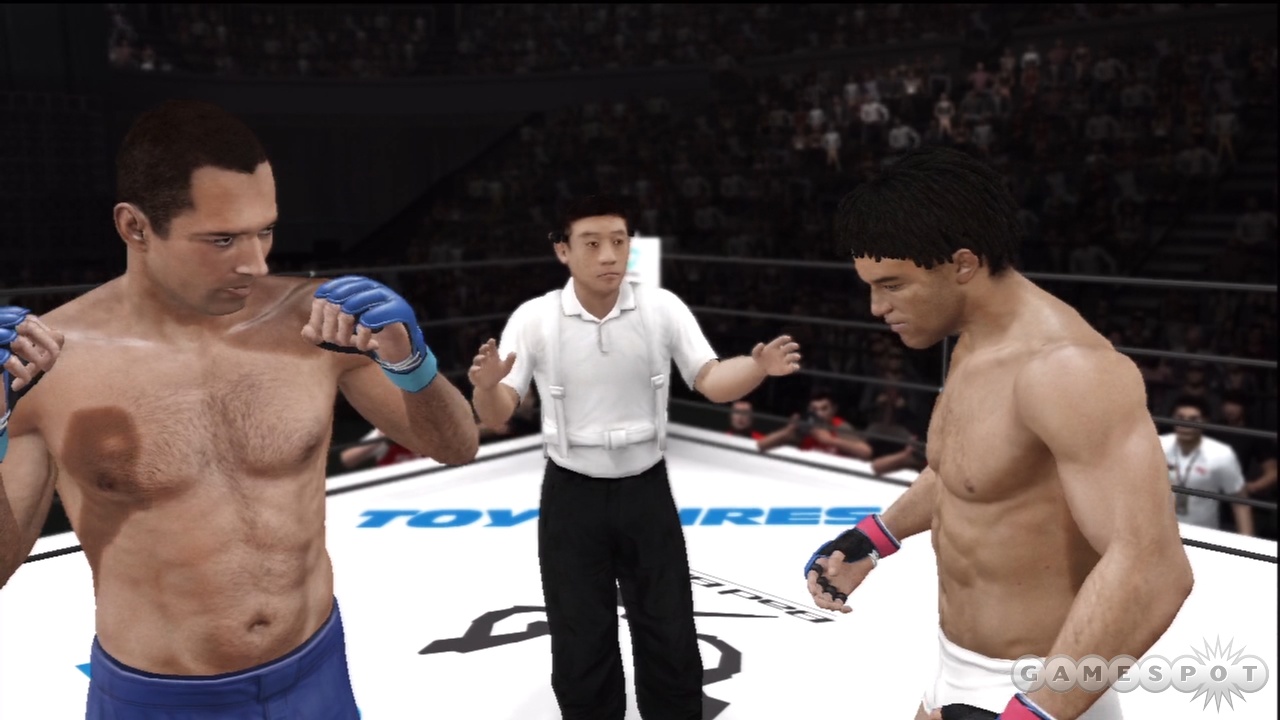While UFC Undisputed games have always offered great mixed martial arts action, UFC Undisputed 3 is the first in the series that also succeeds outside of the octagon. It's also a significantly more accessible game than its predecessors, so you don't need to know a reverse mount from a rear mount to enjoy it.
If you're a newcomer to the series, or just in need of a refresher because you haven't played a UFC game in months, UFC Undisputed 3 has you covered with its comprehensive tutorials. Play through the Guided Tutorial mode's 62 quick exercises, and you learn how to perform everything from simple punches and transitions to dangerous moves like foot stomps and soccer kicks that, while effective in the new Pride competitions, are illegal in UFC matches. Some of the tutorials deal with new or significantly changed gameplay mechanics, so they're worth checking out even if you have previous octagon experience. Submissions are now attempted and defended using an entirely new system, for example.
Rotating the right analog stick as quickly as possible was an inelegant way to resolve submission attempts in previous games, and while it was technically skill-based, it wasn't at all analogous with the struggle onscreen. Thankfully this has been addressed in UFC 3, where submissions employ a minigame of sorts. Two icons representing the fighters move around the perimeter of an octagon-shaped graphic and, depending on whether you're attacking or defending, you either chase or try to stay away from your opponent's icon. It's unfortunate that you end up focusing so intensely on this visual representation of the struggle that you lose sight of the actual fighters, but it's a great system regardless, because it's always clear how well you're doing and what you need to do to improve your situation.
Another interesting improvement inside the octagon is the all-new interaction that you have with your trainer. Not only can he occasionally be heard yelling legitimately useful advice over the noise of the crowd while you're fighting, but in between rounds he offers feedback on both positive and negative aspects of your performance. He might congratulate you on your excellent ground-and-pound work while pointing out that you need to do a better job of blocking your opponent's transitions, for example. Furthermore, you have the option to look at an expanded version of his comments that, often, details what you need to be doing with your controller to act on his advice. MMA fighters have such vast repertoires of moves at their disposal that these reminders can prove invaluable.

If you find the move lists of pro fighters such as Anderson Silva, Cain Velasquez, and Scott Jorgensen overwhelming, a great way to familiarize yourself with the basics is to jump into the much-improved Career mode. There, you start out as a relative newcomer to MMA with a much smaller repertoire and significantly lower ratings for your physical attributes and fight skills. You might feel sluggish and underpowered early on, and it's an odd sensation to find yourself in a position in which you simply don't have good moves available. This forces you to master the basics though, and there's a great sense of progression as you train between fights.
Training hasn't always been much fun in UFC games, largely because so much of it was menu-driven. Thankfully, that's no longer the case. Minigames replace mathematics in UFC Undisputed 3, so where physical training used to take place on a spreadsheet, now it involves punching bags, focus mitts, and the like. Training exercises do a great job of reinforcing the idea that you're improving as a fighter, not only because you inevitably get better at them as your career progresses, but because they employ the same controls as the moves that they most obviously benefit. Grabbing large tires and flipping them around on a mat plays in much the same way that taking down opponents does, for example. Also, you no longer need to concern yourself with working training into your schedule in such a way that you leave enough time before a fight to recuperate.

In UFC 3 you typically get to choose one of five opponents for your next fight and then get just two training sessions beforehand, which you can choose to spend improving your skills and physical attributes, or visiting camps to learn and level up moves. You never have to rest, and you never have to waste time clicking through menus that are presented as media opportunities. You might still end up devoting chunks of time to arranging sponsor logos on your shorts and banner, but you don't need to do this often, and the systems in place for doing so (which also include a new option to design your own logos) are far less unwieldy than in previous UFC games.
Thanks largely to its focus on fighting and fight preparation, Career mode is rarely anything but compelling, and--particularly if you've chosen a challenging difficulty level--you're sure to come away with stories to tell. Maybe you suffered your first career defeat in the dying seconds of a fight that you would surely have won on the judge's scorecards, or earned your first title with a major counterpunch after feeling like you'd already lost the fight. There's potential for memorable moments outside of the ring as well, such as having to choose between a shot at a UFC title and your first opportunity to fight in a Pride tournament, or signing with a gym so that you can learn the most powerful moves that are taught there. You might even find yourself contemplating the new retirement option, if you feel that you've already achieved everything that you set out to.
Regardless of how your lengthy and hopefully illustrious career comes to a close, what you're left with at the end of it is a custom fighter that you know inside and out, and who--depending on how well your training went--can comfortably compete with even top-ranked professionals in other modes. There is an option to create custom fighters and spend points on their abilities without ever going anywhere near Career mode, but you get so few points to spend that you inevitably end up with either a jack-of-all-trades or a master of one. If you want to create a well-rounded fighter, playing through Career mode is a must.
In addition to online matches, which are mostly lag-free this time around, created fighters can be used in custom tournaments against both friends and AI opponents and in the returning Title and Title Defense modes. Title mode is set up much like a traditional fighting game, in that you simply complete a number of fights until you're declared the champion. You can get away with losing up to three times as you battle your way to the top, but any more than that and you have to restart. Playing through Title mode is a great way to familiarize yourself with pro fighters from the roster of over 100, and completing it unlocks the challenging, time-consuming Title Defense mode for play with the fighter that you were using.

Where UFC Undisputed 2010's Title Defense mode challenged you to remain undefeated as you were pitted against a maximum of 12 opponents, this year's is a grueling survival mode in which you're expected to compete in up to 100 championship (that is, five-round) fights back-to-back, and only a certain amount of damage is repaired between fights. Understandably, there's no option to save in Title Defense mode because that would make it too easy to complete. An unfortunate side effect of this is that to get anywhere near that 100th fight, you have to play for a long time. Five-minute rounds in UFC 3 actually last for about half that (the seconds count down more quickly than you'd expect in training sessions as well), but fights that go the distance still last around 15 minutes even if you skip through all of the TV-style presentation to speed things up. Most fights don't go the distance, of course, but even if you conservatively allow just five minutes per fight, you're looking at more than eight hours of uninterrupted play to make it to the end.
Benefiting from a more thoughtful makeover in UFC 3 is the Ultimate Fights mode in which you get to either re-create or rewrite history depending on which fighter you choose to play as in some of UFC and Pride's most memorable fights. Rather than just being given a list of objectives to complete during each fight as in previous games, you're now prompted to complete specific goals as the fight progresses, and you're given a time limit for each. Essentially, you're asked to follow a script. It's an interesting way to play because it forces you to use techniques that you might ignore otherwise, and the archive videos that precede each fight offer welcome trips down memory lane.
Whether you're re-creating UFC 113's Lyoto Machida vs. Shogun Rua matchup, taking on all comers online, or training before a big Career mode fight, UFC Undisputed 3 delivers with its slick presentation and its deep but accessible gameplay. Impressive impact animations ensure that every blow you land successfully feels like a triumph, and it's incredibly satisfying just to take an opponent to the ground or to cut him with an elbow, let alone score a KO. Making your successes even more satisfying is the new option to share your favorite moments (as well as custom logos and fighters) with other players online. At all times, UFC 3 keeps recordings of your last 50 rounds of fighting, and while the in-game editing tools are basic at best, it's possible to cut together good-looking highlight reels up to 60 seconds in length. Following an especially good fight you can even have the game assemble a highlight reel for you automatically, though this takes several minutes, and the results aren't always worth the wait. User ratings ensure that the best content bubbles to the surface, but you might be more inclined to check out highlight videos if you didn't have to download them in their entirety before watching them.
Like the best MMA fighters, UFC Undisputed 3 is well-rounded and impresses in a lot of different areas. It improves upon its predecessors at practically every opportunity and, for the moment, is the undisputed champion of MMA video games.




